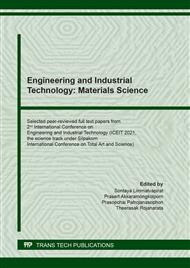p.31
p.37
p.45
p.53
p.63
p.69
p.75
p.81
p.87
Design and Investigation of Optimal Dissolving Polymeric Microneedles for Ocular Application by Using Three-Level Factorial Design
Abstract:
Dissolving microneedles (dis-MNs) are very attractive micro-scale technology and a minimally invasive method to be used as a tool for transdermal delivery, leading to increased bioavailability of drugs bypassing ocular tissue barrier and painless treatment method. This study aims to design and investigate the optimal dis-MNs as a potential device for ocular application using a three-level factorial design. The dis-MNs were fabricated by micromolding technique using chitosan and polyvinyl alcohol (PVA) polymer. The physical appearance of dis-MNs was observed under a digital microscope. The mechanical strength (resistance force and insertion force) was tested with a texture analyzer. The penetration depth and dissolution time at a predetermined time were tested on porcine ocular tissue. The data illustrated that the optimal dis-MNs formulation was 3%chitosan and 20%PVA in 20%PVA in a weight ratio of 1:4. The physical appearance showed pyramidal microneedles with an average 609.01±1.01 µm in height and 200.21+3.57 μm in base width. The optimal dis-MNs showed a resistance force of 40.14±2.10 N. The insertion force into the cornea tissue (1.78 N/225 arrays) was higher than sclera tissue (0.95 N/225 arrays), indicating that the optimal dis-MNs could create micro-channels on both cornea and sclera tissues. The dissolution study showed that the optimal dis-MNs formulation was completely dissolved on cornea tissue (1 min) faster than sclera tissue (3 min). In conclusion, the optimal dis-MNs presented suitable dis-MNs properties with minimally invasive device for ocular tissue, acting as an appropriate dis-MNs model for the ophthalmic drug delivery system.
Info:
Periodical:
Pages:
63-68
Citation:
Online since:
March 2022
Authors:
Price:
Сopyright:
© 2022 Trans Tech Publications Ltd. All Rights Reserved
Share:
Citation:


